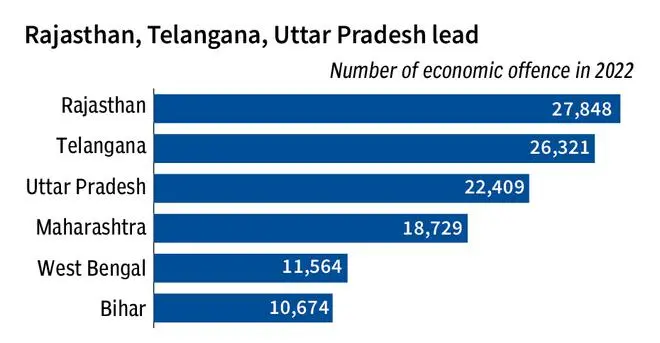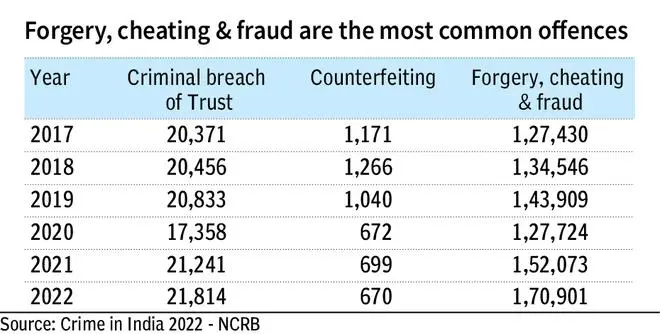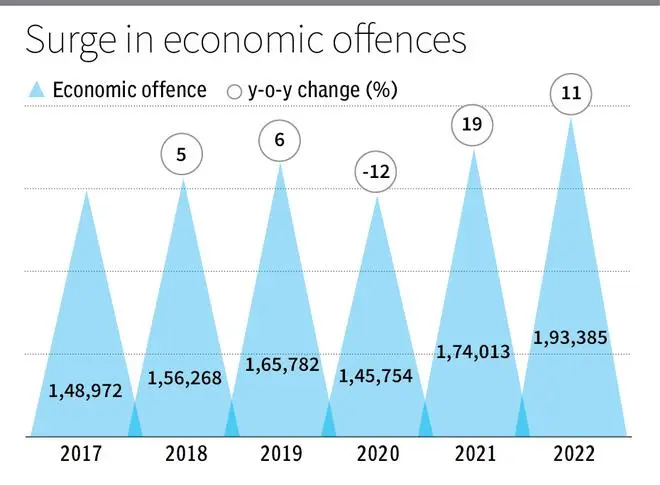There has been a sharp surge in economic offences in 2021 and 2022, according to recently released data from the National Crime Records Bureau. Around 1.93 lakh cases were reported in 2022, 11 per cent higher compared to 2021. Rajasthan reported the maximum number of cases, while most related to forgery, cheating and fraud.
Kerala-based cybersecurity expert and CEO of TechniSanct, Nandakishore Harikumar, suggests that “the increase in reported cases of economic offences in India may be attributed in part to greater awareness among the public. The rising numbers reflect an increased willingness of people to register such cases”.
The data indicate that in 2022, States such as Rajasthan, Telangana, and Uttar Pradesh contributed significantly to registered economic offence cases in India. These States accounted for 14.4 per cent, 13.6 per cent and 11.6 per cent cases, respectively, of the total cases.

In April this year, the Rajasthan government announced the establishment of a Directorate of Revenue Intelligence and Economic Offences to investigate economic offense cases. This decision comes in response to the increasing instances of fraud in the real estate sector, illegal land occupation, and bank credit fraud in rural areas. These incidents have contributed to making Rajasthan a prominent State with a higher number of economic offense cases. Most offences in all the top States are related to criminal breach of trust. Telangana witnessed concentration of these crimes in Hyderabad.
In metro cities, Mumbai reported the maximum number of economic offences at 6,960. This was followed by Hyderabad and Jaipur with 6,015 and 5,332 cases in 2022 .
Forgery, cheating
The NCRB classifies economic offenses into three main categories: forgery, cheating, and fraud (FCF), covering sections 420, 465, 468 of IPC and others. Second is criminal breach of trust (CBT) — it is a form of misappropriation of someone’s property for one’s personal gain, in violation of any legal contract, governed by rules enacted under sections 406 to 409 of IPC. Third is counterfeiting or the illegal manufacture of fake notes, which is covered in sections 231, 243 of IPC and others. Among these, FCF constitutes the majority of cases.

The data reveal an upward trend in FCF cases, with an increase from 1.27 lakh cases in 2017 to 1.70 lakh cases in 2022. On the other hand, CBT increased from 20,371 cases in 2017 to 21,814 cases in 2022. Interestingly, cases registered under counterfeiting have shown a a positive decline, decreasing by half from 1,171 cases in 2017 to 670 cases in 2022.
Low conviction rate
While economic offences are on the rise in India, data reveal a decline in arrests and convictions, accompanied by a surge in pending cases.

According to NCRB, the police arrested 1.69 lakh individuals for economic offences in 2022, with only 16,869 of them being convicted. The backlog of pending cases is particularly noteworthy, with approximately 2.20 lakh cases pending at the end of the year. This results in a pendency percentage of 53.5 per cent.
Harikumar notes that “in today’s interconnected world, instances of forgery often occur in geographically distant parts of the country. The existing intra-State boundaries can pose obstacles for State police in conducting thorough investigations and gathering evidence. This geographical dispersion, coupled with the difficulty in collecting evidence, can contribute to a lower conviction rate”.




